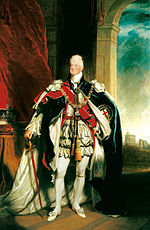- Duke of Clarence
-
For the ship, see TSS Duke of Clarence.
Duke of Clarence is a title which has been traditionally awarded to junior members of the English and British Royal families. The first three creations were in the Peerage of England, the fourth in the Peerage of Great Britain, and the fifth in the Peerage of the United Kingdom.
The title was first granted to Lionel of Antwerp, the third son of King Edward III, in 1362. Since he died without sons, the title became extinct. The title was again created in favour of Thomas of Lancaster, the second son of King Henry IV, in 1412. Upon his death, too, the title became extinct. The last creation in the Peerage of England was for George Plantagenet, brother of King Edward IV, in 1461. The Duke forfeited his title in 1478, after he had been convicted of treason against his brother. He allegedly met his end (according to William Shakespeare) by being drowned in a butt of Malmsey.
A fourth creation in England was suggested and planned to take effect; the title of Duke of Clarence was going to be given to Lord Guilford Dudley, husband of Lady Jane Grey, upon her coronation, as she declined to make her husband king consort. However, she was deposed before this could take effect.
The next creation (Duke of Clarence and St Andrews) was in 1789 for Prince William, third son of King George III. When Prince William succeeded his brother to the throne in 1830, the dukedom merged in the crown.
The most recent creation (Duke of Clarence and Avondale) was for Prince Albert Victor of Wales, the eldest son of Albert Edward, Prince of Wales (later King Edward VII). This was the last royal dukedom to be created with two territorial designations. The Duke died of pneumonia in 1892 and the title again became extinct.
The title also took the form of an earldom for Queen Victoria's son Prince Leopold, Duke of Albany and his son Prince Charles Edward, the Clarence earldom being a subsidiary title.
The title originates[1] from the town of Clare, Suffolk, which was owned by the first duke of Clarence, Lionel of Antwerp. His wife, Elizabeth de Burgh, 4th Countess of Ulster, was a direct descendant of the previous owners, the de Clares, and the Manor of Clare was among the lands which she brought to her husband.[2] After the Union of the Crowns in 1603, the holders of the title were also given titles including Scottish place names, such as St Andrews and Avondale.
Contents
Dukes of Clarence, first Creation (1362)
- also Earl of Ulster (1264) jure uxoris
- Lionel of Antwerp, 1st Duke of Clarence (1338–1368), third (second surviving) son of Edward III, died without male issue
Dukes of Clarence, second Creation (1412)
- also Earl of Aumale (1412)
- Thomas of Lancaster, 1st Duke of Clarence (1388–1421), second son of Henry IV Bolingbroke, died without male issue
Dukes of Clarence, third Creation (1461)
- also Earl of Warwick and Earl of Salisbury (1472)
- George Plantagenet, 1st Duke of Clarence (1449–1478), third son of Richard Plantagenet, 3rd Duke of York and brother to Edward IV and Richard III, was executed for treason in 1478, at which point all of his honours were forfeit.
- His legitimate male line ended with the death in 1499 of his only son Edward Plantagenet, 17th Earl of Warwick.
Dukes of Clarence and St Andrews (1789)
- also Earl of Munster (1789)
- The Prince William, 1st Duke of Clarence and St Andrews (1765–1837), third son of George III, acceded in 1830 as William IV. All of his honours merged with the crown, and he had no legitimate male issue.
Earls of Clarence (1881)
- The Prince Leopold, 1st Duke of Albany, 1st Earl of Clarence & 1st Baron Arklow (1853–1884), fourth son of Queen Victoria
- Charles Edward, Duke of Saxe-Coburg and Gotha, 2nd Duke of Albany, 2nd Earl of Clarence & 2nd Baron Arklow (1884–1954), posthumous son of the 1st Earl, had his British titles suspended in 1919 for waging war against Britain.
- For heirs to the suspended peerages, see Duke of Albany
Dukes of Clarence and Avondale (1890)
- also Earl of Athlone (1890)
- Prince Albert Victor, 1st Duke of Clarence and Avondale (1864–1892), eldest son of The Prince Albert Edward, Prince of Wales (later Edward VII). He predeceased both his father and grandmother, unmarried and without issue.
References
- ^ David Hatton, Clare, Suffolk, an account of historical features of the town, its Priory and its Parish Church, 2006, Book 1, p21 ISBN 0-9524242-3-1 It is also available online on the Clare website
- ^ "Dukes of Clarence", Encyclopædia Britannica Eleventh Edition (1911).
British royal titles Inactive titles Duke of Albany · Duke of Windsor · Duke of Cumberland · Duke of Connaught and Strathearn · Duke of Sussex · Duke of ClarenceCategories:- Dukedoms of England
- Dukedoms of Great Britain
- Dukedoms of the United Kingdom
- Dukes of Clarence
- Extinct British dukedoms
Wikimedia Foundation. 2010.

